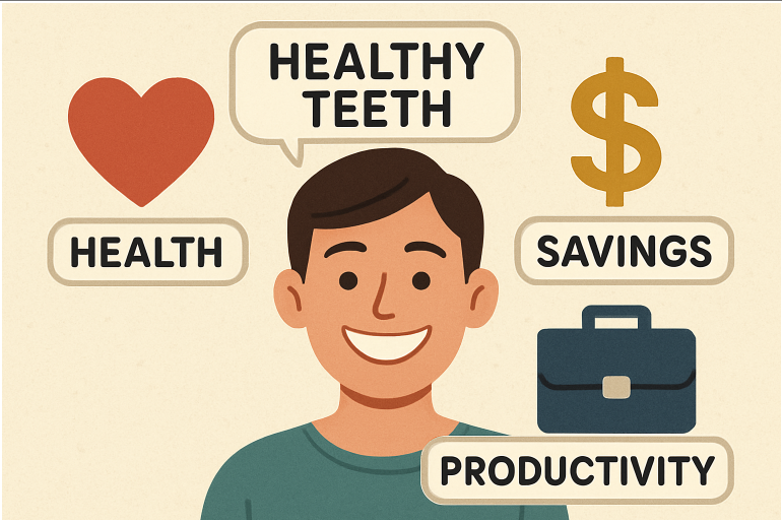Table of Contents
- Introduction
- Oral Health and Systemic Diseases
- Economic Benefits of Preventive Dental Care
- Impact on Workplace Productivity
- Preventive Care During Pandemics
- Recommendations for Dental Visit Frequency
- Conclusion
Introduction
When most people think of good oral hygiene, their minds turn to bright smiles and fresh breath. However, the benefits of preventive dental care extend far beyond cosmetics. Regular dental visits, cleanings, and consistent at-home care routines help prevent oral health issues and protect your entire body from more serious diseases. Embracing preventive strategies and options, such as HMO dental insurance, makes it easier for families and individuals to access routine dental care without incurring unnecessary financial burdens.
Examining oral health as an essential aspect of overall wellness highlights its far-reaching effects. Research shows that keeping your teeth and gums healthy not only saves you money in the long run but may also prevent certain chronic illnesses. By understanding how preventive dental care contributes to long-term well-being, you’re empowered to make more informed choices about your health plan and daily habits.
Beyond the individual, strong oral health benefits society by reducing healthcare costs and supporting workplace productivity. During times of crisis, such as the COVID-19 pandemic, the importance of maintaining regular dental check-ups becomes especially clear, as it prevents minor problems from escalating into major health emergencies. Addressing disparities and advocating for regular care supports community health, economic stability, and quality of life.
Most dental professionals now recommend that your visit schedule be tailored to your unique health profile, and various evidence-based approaches help ensure preventive care meets modern needs. This guide explores the many ways preventive dentistry protects your overall health, your wallet, and supports a resilient, healthier society.
Oral Health and Systemic Diseases
The mouth is more than just the entry point for nutrition; it’s an integral part of the body’s systems. Poor oral health—such as untreated cavities or gum disease—has been linked to a higher risk of several chronic diseases. For instance, bacteria from inflamed gums can enter the bloodstream and worsen conditions like heart disease, diabetes, and respiratory infections. The Centers for Disease Control and Prevention (CDC) reports that systemic diseases are often connected to poor oral health, making prevention crucial, especially within marginalized communities where dental care disparities are more common.
Conditions like periodontitis (advanced gum disease) are now recognized as significant risk factors for cardiovascular disease. There is also compelling evidence that dental caries and untreated oral infections increase the risk of adverse pregnancy outcomes and complications in people living with diabetes. This interconnectedness demonstrates that preventive dental care is as much about whole-body wellness as it is about protecting teeth.

Economic Benefits of Preventive Dental Care
One of the most tangible advantages of preventive dental care is the money saved over time. Regular cleanings and dental assessments significantly reduce the likelihood of needing complex, costly treatments for problems like root canals, crowns, or emergency visits. According to Health.com, adults with chronic health conditions—such as diabetes and coronary artery disease—who maintain routine dental appointments save, on average, $550 annually in healthcare costs.
Routine preventive care, supported by accessible insurance plans, helps families and individuals maintain oral health without high out-of-pocket costs. For many, HMO dental insurance plans provide predictable coverage for check-ups, cleanings, and X-rays, making essential care accessible and supporting overall financial well-being. Forbes Health further emphasizes the value of preventive dental coverage for comprehensive long-term savings.
Impact on Workplace Productivity
The effects of oral health go beyond individual well-being to impact broader societal and business outcomes. Oral pain and dental emergencies are leading causes of lost productivity—Americans collectively lose more than 92 million hours of work and school each year due to unexpected dental visits, according to the American Dental Association. Progressive employers who promote and support preventive dental benefits typically see reduced absenteeism and greater productivity among their teams. As highlighted by HR Dive, workers who regularly use preventive dental services file fewer claims for restorative dental work, which supports lower overall premiums and healthier workforces.
Preventive Care During Pandemics
The global COVID-19 pandemic highlighted the far-reaching impact of disruptions to preventive healthcare, including dental care. Studies published by the Journal of the American Dental Association found that dental visits for preventive care sharply declined, especially among working-age adults. This lapse has fueled concerns about the consequences of untreated decay and gum disease, as even short-term gaps in care can lead to serious, expensive complications later on. These findings are supported by recent research highlighting the need to prioritize dental care even during public health challenges.
Recommendations for Dental Visit Frequency
Conventional wisdom once held that everyone should visit their dentist twice a year. The American Dental Association now recommends a more personalized approach: your visit frequency should match your specific oral health risk factors. Most adults benefit from two preventive visits annually. Still, some—such as older adults, those with chronic diseases, or individuals who smoke—may need appointments as often as every three to six months. The New York Times provides further insights on tailoring dental visit schedules to individual needs for optimal health outcomes.
Conclusion
Preventive dental care is a key strategy in safeguarding both your oral and overall health. By prioritizing regular check-ups, cleanings, and at-home care routines, you can substantially reduce your risk of serious disease, minimize long-term health costs, and improve your quality of life. Investing in preventive dental care is not just about protecting your teeth—it’s a foundational commitment to greater health and resilience for yourself and your family.
